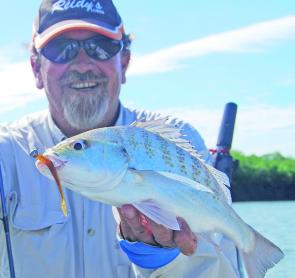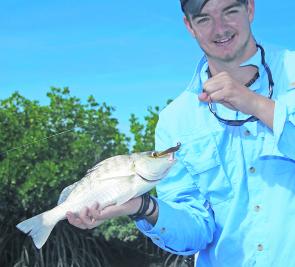The 1-3kg rod, the hair-thin braid and the finesse rubber have long been the vaunted tools of the southern bream angler, but things are changing as good news spreads! A small group of specialist anglers are paving the way for an estuary fishing metamorphosis that is introducing lightweight spinning techniques to the warm waters of the north.
While it never pays to underestimate the pulling power of a bream in structure, imagine fighting a 1kg grunter beside a rock bar or a 2kg fingermark holding on a submerged tree, and then imagine doing it on 1-3kg tackle! This is exactly the kind of insane sportsfishing that northern anglers like Seaforth Fishing Charter’s owner and operator, Arthur Lavern, and many others are switching to in an effort to maximise their catch and the high adrenalin aspect of their fishing.
However, why risk losing trophy fish by bringing an oyster knife to a gunfight, so to speak? Well there are several reasons:
Many northern species, like grunter, jacks, trevally, queenfish and fingermark, love to eat the tiny fingernail sized whitebait and jelly prawns that densely populate estuary systems and creeks. Not only are 2-3” soft plastics dead ringers for these tiny baitfish, they are also incredibly life-like when rigged with a pea-sized jighead and twitched along the bottom.
The Mackay region’s best known estuary guide, Arthur Lavern, first showed me the effectiveness of this technique last year when I was lucky enough to join him for an afternoon on the water. I was totally blown away by the sheer volume of fish life that the little plastics attracted, and I was also shocked by the quality of the fish that were beatable on 1-3kg gear. It rocked my socks!
Initially I was very sceptical of such dainty hardware and miniscule software, but almost as soon as we’d reached Arthur’s secret spot every cast was met with enquiries, both timid and fierce. It took some getting used to, but after several misses I was able to catch a few hard fighting grunter and a couple of bream. Meanwhile, Arthur was slaying them at his end of the boat and seemed to be catching a fish a cast. It was unreal!
To top the day off, Arthur pointed at a small mangrove bend and said, “There’s fingermark there”. Three casts later and he was locked in a very tenuous battle with a glistening golden shape that proved to be a beautiful fingermark. On such light tackle it was a pleasure to watch a pro at work, which brings me to my second reason.
When you’re fishing the tight corners of a creek at low tide or the exposed gravel headlands at high tide, there’s plenty of room to play a feisty fish, so why not downgrade your tackle and take things to the limit?
Grunter are not a regular capture while casting lures on your overhead combos; you don’t have the feel, profile or casting distance to really target them. On light spin gear however, you gain the finesse required to tempt them and then hook them. From then on, it’s just a matter of having the time of your life as you endeavour to turn them on light gear.
Such battles with grunter (and several exciting species that make up regular by-catch) are epic in proportion. The drag squeals, the rod bends to heart-stopping angles and from the first tap to the scoop of the landing net, everything becomes a matter of precision and patience. One legal fish can leave you tied in knots as you run around the boat, dipping, diving and plunging your rod into the water as the fish reaches its full potential.
Light tackle in the estuaries makes catching a fish into a adrenalin pumping battle that leaves you with a sense of real accomplishment and if you do get busted off, you can usually get straight back in there and into the action.
Even if you’re not really into adrenalin-pumping angling, the truth of the matter is you will catch more fish on light gear. Going lighter allows you to capitalise on a whole range of species that mid-weighted tackle leaves behind.
Small plastics attract more hits, taps and nibbles, which make it easier to hook interested fish. It’s all about finesse and sensitivity. You can cast deep into the strike-zone, and then work your lure out with the most appetising retrieve possible and, when the fish makes an enquiry, you can feel every step of the hook up process. Put simply, light tackle takes the guesswork out of estuary lure tossing!
However, I’ll be honest with you and say a slow day’s fishing might include dozens of undersized estuary species and the one fish that is legal might bust you off after an intense battle. But don’t be disheartened, if you were using heavier gear it’s very likely that you wouldn’t hook any of the undersized fish and the larger fish might not be tempted by a large profiled lure worked with thick leader and 30lb braid!
The best way to work estuaries in this manner is by casting deep bends/holes or shingle patches with lightly weighted plastics in natural colours (pumpkin seed, grey, smelt and such), then allow the plastic to settle on the bottom before giving it three sharp twitches, wind up the slack and repeat the process.
The pros will tell you that this action is ‘all in the wrist’ and a twitch that uses your arm is too vicious. Also, remember to always remain vigilant, as enquiries will often be felt as the slightest vibration through the rod blank and often come as the lure resettles on the bottom.
While this technique is very effective, light tackle gives you a multitude of options, including the use of un-weighted/weedless plastics and resin headed plastics, which because of their slow sinking action are ideal for working snags and rocky outcrops. Just be willing to beef up you leader, otherwise the fight might be over before it has begun.
Another light option involves rigging a plastic with a resin head or worm hook and then twitching it across the surface with the rod tip held vertically. This creates a very natural surface rippling presentation that closely resembles a floundering bug, lizard or mudskipper. And don’t forget the fast retrieve either.
Brightly coloured plastics (pink, red or green) can be lethal for queenfish and trevally when rapidly twitched off draining flats towards the bottom of the tide.
It might not be the only option for most northern anglers, but do your-self a favour and make it an option. Pack the light spin stick on your next estuary jaunt and if it’s a slow day try flicking some shingle banks with the light plastics. You’ve got nothing to lose and a hell of a lot of fun to be had! So, fish hard, stay safe and hopefully I’ll catch you somewhere on the water.
Facts
The Outfit
• A lightweight graphite blank (7’ or longer) with a whippy, sensitive tip to maximise casting distance and feel (1-3kg or 2-4kg).
• A small, tough 1000 or 2500 size reel with between 2kg and 5kg braid.
• A good quality non-abrasive leader that is heavier than 6kg. These northern fish often come with teeth!
Dia.
The three flick method is an ideal way of keeping your plastic near the strike zone while maximising its natural presentation.

Fingermark are tough customers but are well worth the battle.

Fish like this are smart so sometimes it takes light tackle to tempt them.

Note the small jighead - this allows the plastic to swim naturally.

Local guide Arthur Lavern catches fish like this almost daily. What a job!

Little grunter love small plastics.

One of many the competitors for quality estuary fish.




